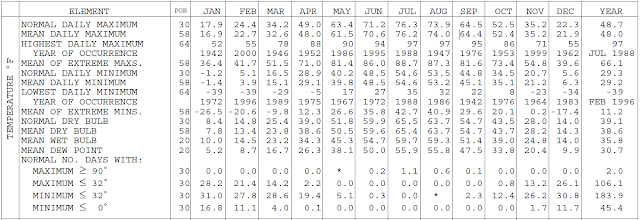Blog1: Duluth, MN
Geographically speaking, Duluth's location
(Lat/Long: 46.787, -92.098) falls but a few hundred miles from the center of
North America. This would lead one to
suspect a fully continental climate, however, Duluth's proximity to Lake
Superior, the largest and coldest Great Lake, brings a marine influence to the
climate of this small city founded at the natural harbor on the furthest
southwest extent of lake.
 |
| Ice fog, likely caused by cold land-based winds moving over the warmer open water, seen over Lake Superior with Duluth Harbor in the foreground. |
While the
city is centered on the lower areas near the harbor, the city has grown onto
the hills directly to the west that rise 600-800 feet above the lake. The surrounding region is characterized by
humid, deciduous forest pockmarked with innumerous lakes which canvas the
glacially-scarred landscape.
 | ||
Average monthy precipitation and temperature ranges covey the harsh winters and mild summers in Duluth. Yearly mean daily maximum temperatures for the year is 48°F; records show daily minumums have been as low as -39°F and daily maximums have not exceeded 97°F. December, January and February receive significantly less precipitation than other months, however, snowfalls of over 30" have been recorded during this drier period.
Although, open water influences heat fluxes in
Duluth, the sensible heat flux plays a large role due to the continentality of the
region. In general, this value is expected to fall below the average ratio of North America (0.74); an estimated Bowen Ratio is
0.5, which postulates that about twice as much energy exchange is involved in the latent heat flux than in the sensible heat flux.
GeeBIT
A) 0.406 Albedo = 4.0°C
0.206 Albedo = 24.8°C
B) G.H. Factor of 1.1 = 17.7°C
G.H. Factor of 0.9 = 12.1°C
C) An increase to the albedo or decrease in the greenhouse factor would cause even cooler temperatures, and the harbor would likely remain frozen longer, affecting commerce. Conversely, decreasing albedo and increasing the greenhouse effect would bridle the areas adiabatic cooling and bring more continental summer temperatures.
References:
Climate for Duluth, MN. (n.d.). Retrieved from http://www.rssweather.com/climate/Minnesota/Duluth/
Duluth, MN: Storm Tracks. (n.d.). Retrieved from http://snincr.net/winter_profiles/DuluthMN.html
Normals, means, and extremes: Duluth, mn . (n.d.). Retrieved from http://climate.umn.edu/pdf/normals_means_and_extremes/2005_Annual_LCD_DLH_page_3.pdf
O'Hara, D. (Photographer). (n.d.). Cold Glow. [Web Photo]. Retrieved from http://www.northernimages.com/Duluth/Weather/Duluth-Weather/7756706_sZM4q2/501596988_S5jNb
Richardson, H. W. The Climate of Duluth. (pp. 17-29). Duluth: Commercial Club of Duluth.
|


